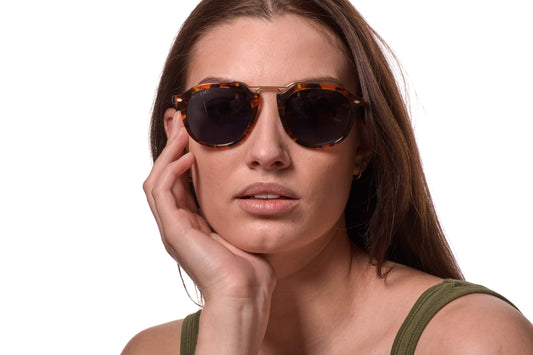


Sunglasses & Materials
Sunglasses are made up of three different parts: frame, temples, and lenses. The frame includes several elements like the nose pad, bridge, and part of the hinge. The temples include the other half of the hinge which is then fastened to the frame using a screw, glue, or heat. Each part is made individually and then assembled to create a finished pair.
Sunglasses manufacturing processes have become increasingly sophisticated in response to greater demand for high quality, stylish glasses.
Upscale manufacturers use combinations of nickel, silver, stainless steel, graphite, and nylon in their leading-edge designs.
Metal
Higher-end sunglasses will have metal frames because they are durable and lightweight. Metal frames can be made from nickel, stainless steel, aluminum, or titanium.
Acetate
Acetate is a nylon-based plastic, meaning that it’s a lot stronger, more durable, and flexible than regular plastic which explains why it’s useful for eyeglasses frames. It is more resistant to pressure placed upon the frames and can bend further before breaking.
Acetate is a different kind of plastic. One that is plant-based—so from a renewable resource—and is also hypoallergenic. Cellulose acetate is a non-petroleum based plastic that is made from natural cotton and wood fibers. While petroleum products can be more expensive and harmful to the environment, cellulose acetate is made from renewable materials. Cellulose Acetate for eyewear is made by forming layers of plastic into large blocks then carefully slicing individual parts, hand polishing and finally assembling them into a frame.
Acetate is made by cutting, forming, and polishing multiple sheets of plastic which gives it its strength even as a plastic and makes it ideal in use for eyeglasses frames. Conventional plastic eyeglasses frames are a mixture of different substances which are essentially molded into a frame shape. With acetate the process takes longer because it’s multiple sheets coming together rather than one simple molding process.
One thing to keep in mind is that acetate eyeglasses frames are primarily designed with fashion in mind and the objective in using acetate is to achieve eyeglasses frames which can truly attest to being defined as fashionable and stylish.
Acetate makes design better and easier to retain unlike the other two media for eyeglasses frames. This is primarily owing to the fact that acetate is carved out of rich colored blocks and layered with multiple sheets of these colors. By layering these colors, they are retained more effectively as designs and patterns are embedded as opposed to being sprayed on or painted on.
Italian acetate, such as Mazzucchelli, has it’s benefits as well. The Italians are brilliant craft workers with a long history working with acetate. Mazzucchelli has a different process in how they cut and cure the material which is called “block acetate”. The result is some of the most beautiful “Havana” tortoise color acetate on the market. With nice blending of the light and dark spots of a tortoise color.
A special type of absorbing lens filters out polarized light.
Choosing a frame is nearly as important as the lenses, since it contributes to your sunglasses' comfort, durability and safety.
Interchangeable lenses: Some sunglass styles come with interchangeable (removable) lenses of different colors. These multi-lens systems allow you to tailor your eye protection to your activities and conditions.





